VVAM Newsletter 51 – 1993
MUSEUM
Utrechtseweg 232 6862 AZ Oosterbeek The Netherlands
Representative in Great Britain: Mr. EE. Shaw
298 Totnes Road
Paignton – Devon TQ4 7HD
NEWSLETTER No. 51, August 1993
Obituary: Major-General John Frost
Major-General John Dutton Frost passed away on the 21st of May last after a long illness. A serious heart complaint and cancer fell even the strongest among us. He was almost 81 years of age. Many people were aware that he was in poor health, but nevertheless the news of his death came as a great shock. He was the last remaining battalion commander from the Battle of Arnhem, following the death a few months previously of Brigadier-General Tommy Haddon of the then Border Regiment. Frost was born in India in 1912. After his graduation from the Military Academy, Sandhurst, he was appointed to the Cameronians.
At his own request he was assigned to the Special Air Service, after which he was given command of the 2nd Parachute Battalion. Before that, as a company commander he led the daring raid on a German radar installation at Bruneval on the French north coast. From that raid the radar installation’s most important components were brought back across the channel for inspection. He earned his greatest fame in 1944 when he, along with his battalion, defended the northern end of the bridge in Arnhem from the
Sunday evening of 17 September until early on the following Thursday, twice as long as his orders stipulated.
He was wounded and spent the remainder of the war in a prisoner-of-war camp. Later on in Iris military career he became, among other things, commander of the 52nd Lowland Division and commanding officer of the British forces in Malta and Libya.
Following his retirement in 1967 he took up farming. Frost, in common with other veterans who had acted as advisors in the making of the film “A Bridge Too Far”, was unhappy with the end result because various scenes deviated greatly from the historical facts.
On the 16th of September 1978, the road bridge over the Rhine in Arnhem, destroyed just after the battle and later rebuilt, was renamed the ‘John Frostbrug’ (John Frost Bridge). He served many times as “leader of the pilgrimage”, the pilgrimages taking place in September, and on these occasions he never neglected to visit the museum.
He would often arrive at eleven o’clock in the morning, direct from Schiphol, with the complaint: “They didn’t give me any breakfast on board. Could I have a large whisky?”.
An amiable and brave man is no more.
We wish his wife and family strength at this sad time: we shall miss him.
(A.G.)
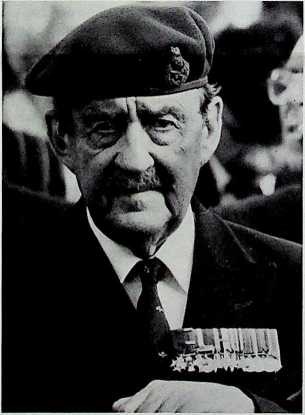
Major-General John Frost during the commemoration of 1989. (photo: B. de Reus)
From the editorial staff
This Newsletter appears shortly before the 49th anniversary of the Battle of Arnhem. The programme for the commemoration has appeared in various local and regional newspapers. However, since many of our members do not live in the Arnhem area we enclose the official programme with this Newsletter, as is our tradition.
In this way every member of the Society is kept up to date and can, hopefully, take part in the commemoration.
The following persons have applied to become “life members”: Mrs. R.C. Peeters from Middelburg, Mrs. C.P. van de Ende-Voorwinden from Oosterbeek, Mr. M.O. van de Mark from Amsterdam, Mr. W. Moller from Oosterbeek, Mr. H. Caperts from Heelsum and Mr. and Mrs. Heerma van Vos from Leeuwarden.
Walking excursion generated great interest
Favoured with excellent weather, the Friends of the Airborne Museum Society’s annual excursion took place on Saturday the 3rd of July. This time the subject was “Operation BERLIN”. The around 90 participants were received in the morning at the Airborne Museum where Mr. Van Roekel gave a short introduction. The participants then left in small groups for the Rhine, with short breaks in between for walks in the “Hemelse Berg” woods and the water meadows. On the way, Messrs. Groeneweg and Van Roekel provided explanations. At the Rhine, the special guest, Mr. MJ. Knottenbelt, told of his experiences during the night withdrawal across the Rhine. At the beginning of the war Mr. Knottenbelt underwent commando training in England. He was a 1st Lieutenant in September 1944 and commanded the Dutch Liaison Mission whose job it was to gather information and to coordinate the participation of the underground groups present at Arnhem.
After visiting the spot where the withdrawal took place lunch was taken in the Concert Hall, after which Mr. Duinhoven gave an explanatory talk in the Old Church. The groups then walked to De Dam via the Beneden-Weverstraat. At the Beneden- Weverstraat, Mr. Voskuil talked about the street fighting which had occurred in that area. Mr. Maassen gave a discourse at De Dam with the aid of German photographs.
The groups finally returned to Hartenstein via the Hazenakker and the Pietersberg.
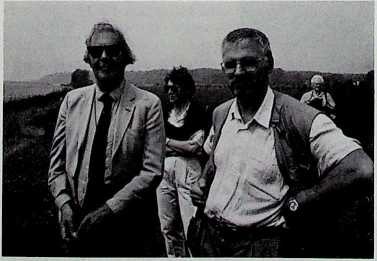
Mr. M.J. Knottenbelt (left) provides an explanation during the excursion at the spot where he withdrew across the Rhine on the night of 25/26 September 1944. Wiebo Boersma listens attentively, (photo: A./. van Hees)
The action started by us in the spring for the financing, by the Friends, of a new diorama in the cellar of the Airborne Museum is progressing extremely well. Up to now approximately 360 square decimeters of the rear wall have been sponsored by the Dutch Friends, whilst in Britain a contribution of around 1600 pounds sterling has been made. Added to a few special gifts and the share which will come out of the Society’s coffers, this makes over 51,000 guilders from the Friends for the Airborne Museum renovation. Very many thanks!
(R. Fennema, Treasurer)
“Facelift” lottery
Thanks to the enthusiastic cooperation of very many of our members, our lottery promises to be an outstanding success. Of the 10,000 lottery tickets available for sale, more than half had already been sold before the first periodical draw, which took place on the 30th of July last. The draw was made, free of charge, by the Solicitors firm W.L. Docter in Oosterbeek. For this we offer our grateful thanks! What is most heartwarming is the application and enthusiasm with which various members have set about selling the lottery tickets. Three members have sold more than 400 tickets between them, and a young girl has taken it upon herself to sell tickets in the whole of Doorwerth. Many members ordered one or more extra books of tickets, and tickets have even been sold as far afield as Zeeland, Limburg and Friesland.
Apart from the financial benefits for the museum’s renovation, this is of inestimable value as an advertisement, both for our museum and for our Society of Friends.
Although the lottery is far from over, the workgroup is confident that it is doing a good job in its organisation of the “Facelift” lottery, judging by the results achieved so far by so many members. A special word of appreciation goes to the Oosterbeek businesses which have expressed their sympathy for the museum and our lottery by contributing many, often valuable, prizes. Not only the long established businesses in Oosterbeek but also the more recently established shops realize the importance of the Airborne Museum to our local and regional communities, and they have shown this in a heartwarming manner.
Although only a few lottery tickets have been returned, the workgroup understands entirely the reasons for this, which are often on grounds of principle or poor health. Of course, it has had reactions of a less encouraging nature but these can be counted on the fingers of one hand!
You can gather from the above that our lottery is going well. About 5,000 tickets have already been sold, which means that there are still around 5,000 in the possession of members or in the hands of the workgroup. This doesn’t matter because everyone is included in the draw for the month in which the tickets are sent in. In any case, the final draw is to be held on the 15th of December, thus giving every ticket two prize winning chances: 1 in 50, and for the complete draw, 1 in 25. This means that we have an incredible 400 prizes at our disposal. The value of these prizes varies but there are some which really stand out, such as a beautiful wall clock worth 800 guilders, an expensive folding bicycle, etc..
The prizes for the various draws will be fairly distributed under the supervision of Mr. Docter, and every winner will be notified personally.
Furthermore, the lists of winners will be published in the local newspaper “Hoog en Laag” as well as in an enclosure to the Dutch version of our Newsletter. The gifts for the members who have sold two or more books of tickets will be sent out on the completion of the lottery.
However, should you still have tickets in your possession and, despite all efforts see no possibility of selling them, just send them back. As well as being sold by individual members, the group also sells the tickets at various functions, such as summer markets, summer parties, military unit open days, the Nijmegen March, the Airborne Walk and the Pegasus Walk. It would be a great shame if tickets were left lying around unsold since, clearly, the initiative will only be considered a complete success if a return is realised on the full 10,000 tickets.
We can then place the resulting monies, less expenses, at the disposal of the museum in December.
(“Facelift” lottery workgroup)
Commemorative envelope withr the PEGASUS operations as theme
The commemorative envelope this year has the PEGASUS I and II operations of 1944, and the PEGASUS walk which stemmed from these, as its theme. This year will see the tenth such walk and it will take place on Saturday 23 October.
An edition of 500 signed commemorative envelopes, each bearing a small map of the route, will appear on the 17th of September. The envelope will also bear the double “Oranje” stamp which was issued on the 15th of May, and the stamps will be franked “17 September 1993”. The envelopes will be available at the Airborne Museum, price 5 guilders each.
Signed 1992 commemorative envelopes available
Last year the commemorative envelope issued by the Airborne Museum was dedicated to No. 2 Dutch Troop, No. 10 (Inter-allied) Commando.
During his visit to the Airborne Museum on the 3rd of July last, Mr. Knottenbelt, who held the rank of 1st Lieutenant and commanded the Dutch Liaison Mission in September 1944, signed the remaining 100 “1992” envelopes. These signed envelopes are available at the Airborne Museum, price 5 guilders each.
Reproductions of
David Shepherd’s paintings available
The British artist David Shepherd has given the Airborne Museum permission to issue reproductions of his paintings, “Arnhem Bridge 5pm The Second Day” and “Oosterbeek Cross Roads – 22 September 1944”, on a once only basis. These reproductions are available at the museum and cost 12,50 guilders each.
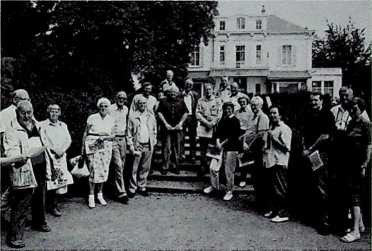
A small group of “excursionists” poses at the rear of the Airborne Museum, (photo: A.J. van Hees)
Exceptional acquisition
Some time ago, a breech block from a 75mm Pack howitzer was found in the water meadows near the Old Church in Lower Oosterbeek. It comes from one of the Light Regiment Royal Artillery’s guns, which were located in the area of the Old Church in September 1944. When the Battle of Arnhem came to an end, the gun crews disabled their guns by removing the breech blocks, sights etc. The breech block has been handed over to the Airborne Museum, and in the future it will be on show in the new diorama under construction in the cellar.
“Spy in the garden”
In 1992, the book “Spion in de tuin – King Kong voor en na zijn dood” (“Spy in the garden – King Kong before and after his death”) appeared. It was written by Bob de Graaff. The publication came six years after the release by the Dutch government of files concerning the double spy Christiaan Lindemans, better known as King Kong. Among other publications, this releasing of files resulted in the book “King Kong; leven, dood en opstanding van een verrader” (“King Kong; life, death and resurrection of a traitor”), written by Frans Dekkers.
Bob de Graaff has mainly used archive material which has appeared since that time. He has made a praiseworthy attempt to answer the still unanswered questions. How often did Lindemans meet Prince Bernhard? What did the Prince tell him? Did King
Kong betray operation Market Garden? The book concentrates chiefly on an aspect which, up to now, has received little attention: the period between the Battle of Arnhem and the exposing and arrest of King Kong more than a month later. From the book “Spion in de tuin” it appears that, at that time, Lindemans was a regular visitor at Prince Bernhard’s headquarters, and that he, the Prince, had no doubts about King Kong’s trustworthiness in the beginning. The book is highly recommended. The 224 page pocket edition (from publishers SDU; ISBN 90- 12-08005-3) is available at all regular bookshops in The Netherlands, price 39,90 guilders.
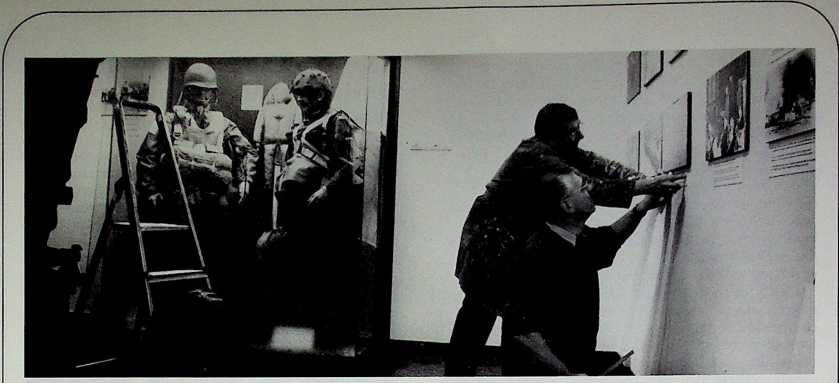
Eef Vellinga and Wiebo Boersma hang new photographs in one of the lower rooms as part of the Airborne Museum renovation, (photo: B. de Reus)
Presentation of the book “Arnhem after Arnhem”
On the 19th of May last, a presentation was made in the Airborne Museum “Hartenstein”, of the book “Arnhem after Arnhem – The Arnhem and Oosterbeek Civilians Fight for Survival”. The compiler of the book, British Airborne veteran Robert Stopforth, presented the first copy to the burgomaster of Renkum, Drs. J.W.A.M. Verlinden. The publication contains stories from the civilian inhabitants of the Arnhem and Renkum districts, who have put their Second World War experiences down on paper. The events presented in the book occurred chiefly during and after the Battle of Arnhem, although the period before 17 September 1944 is also mentioned.
The five chapters (in English) contain a total of 67 stories, including a number which were published earlier in Dutch. This 403 page edition from Stop Press Books, Grimsby, is illustrated with drawings by Mr. Dave Hutson and costs 35 guilders. Those interested in obtaining a copy can contact Mr. Gerrit Willink, van Toulon van der Koogweg 86, 6862 FG Oosterbeek, The Netherlands, telephone number 085-332638.
Decoration for Airborne veteran
Next September, one of our British members, Mr. Eric W. Mills, will become a “Member of the Order of the British Empire” (MBE). Eric Mills receives this award for his services during World War If and for his services to the British community in his home town of Stavanger, Norway. During the war Eric served as a gunner/driver with the 1st Airlanding Light Regiment, Royal Artillery, and he took part in operations in North Africa, Italy, Arnhem and Stavanger.
During the Battle of Arnhem, he fought with his unit in the Benedendorp in Oosterbeek. He returned to Oosterbeek for the first time in 1984, in order to take part in the commemorative events.
(E. van Dam, Oosterbeek)
From the “suggestion box”
Opposite the coffee room in the Airborne Museum is a “suggestion box” in which visitors can place their comments and suggestions regarding the museum. From now on we shall include a few of these comments or suggestions in every Newsletter.
1. No suggestions but a thank you that everything in this museum looks so tidy. It is a shame that museums such as this exist; without wars they wouldn’t be necessary. But this museum’s function is optimally fulfilled, not least because it is so well looked after.
2. The caption by the instruments from a glider states, “altimeter, stopped at 1020 feet”. This 1020 is, however, not height in feet but pressure in millibars; it is thus a sort of barometer, such as can still be found in gliders as part of the altimeter.
3. Excellent presentation but one very small error. Noticed wedding ring is shown on right hand of 101 Airborne Div. paratrooper. We always wear our wedding ring on the left hand.

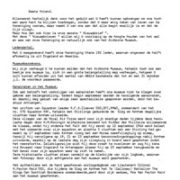
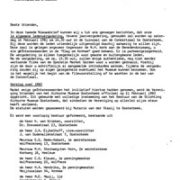
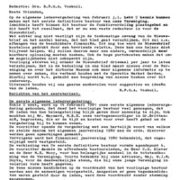
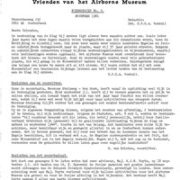
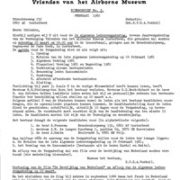
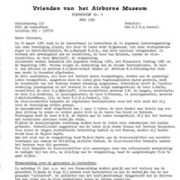
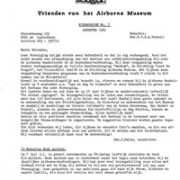
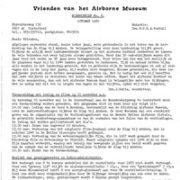
Plaats een Reactie
Vraag of reactie?Laat hier uw reactie achter.